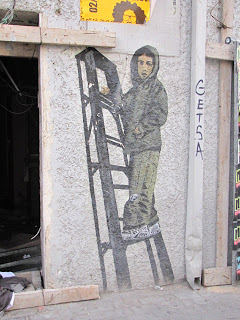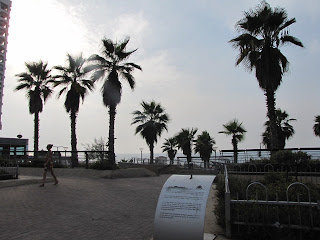Another good day!
With the rental car we decided to take a trip to the north of the country. It was a long day - almost 12 hours - but we covered so much ground.
These are buildings in Arabs town that we encountered along the way. Because the geography here is very hilly, most of the nice houses are built on the top of the mountains.
I wish I could fly. Just hanging on up there.
We had a chance to see some different vegetation from very dry to super green.
There are lots of plantations in this area. Banana, pomegranate, pumpkin, pomelo, orange and more. Lots of them are growing in kibutz's.
Our first stop was in another biblical site: the Sea of Galilee.
FROM WIKIPEDIA:
The Sea of Galilee, also Kinneret, Lake of Gennesaret, or Lake Tiberias is the largest freshwater lake in Israel, and it is approximately 53 km (33 mi) in circumference, about 21 km (13 mi) long, and 13 km (8.1 mi) wide. The lake has a total area of 166 km2 (64 sq mi), and a maximum depth of approximately 43 m (141 feet). At 211.315 metres (693.29 ft) below sea level, it is the lowest freshwater lake on Earth and the second-lowest lake overall (after the Dead Sea, a saltwater lake). The lake is fed partly by underground springs although its main source is the Jordan River which flows through it from north to south.
We didn't have a chance to visit a kibbutz during this trip, but we drove through one (Ein Gev) and by many, giving us an idea of what it's like to be a part of it.
In 2010, there were 270 kibbutzim in Israel. Their factories and farms account for 9% of Israel’s industrial output, worth US$8 billion, and 40% of its agricultural output, worth over $1.7 billion.
This is probably the most important body of water for Israel, since almost all the fresh water to supply the country comes from here. The government monitors the water levels daily.
The water was delicious! It was a great break after spending a couple of hours in the car to get here.
Across from the Sea of Galilee there is the spectacular Golan Heights, also an important site for its strategic location. The plateau is surrounded by four countries: Israel, Syria, Jordan and Lebanon, so you can only imagine the kind of battles that have been taking place here for hundreds of years. This photo shows the fences dividing Israel and Jordan.
FROM WIKIPEDIA:
also called the Golan or the Syrian Golan, forms a rocky plateau in the Anti-Lebanon mountains that overlooks southern Syria. The region attracts three million tourists a year and supplies Israel with one-third of its water.
The earliest evidence of human habitation dates to the
Upper Paleolithic period.According to the
Bible, an
Amorite Kingdom in
Bashan was conquered by Israelites during the reign of
King Og. Throughout the Old Testament period, the Golan was "the focus of a power struggle between the Kings of Israel and the Aramaeans who were based near modern-day Damascus." The
Itureans, an
Arab or
Aramaic people, settled there in the 2nd century BCE and remained until the end of the Byzantine period. Organized Jewish settlement in the region came to an end in 636 CE when it was conquered by
Arabs under
Umar ibn al-Khattāb. In the 16th century, the Golan was conquered by the
Ottoman Empire and was part of the
Vilayet of Damascus until it was transferred to
French control in 1918. When the mandate terminated in 1946, it became part of the newly independent
Syrian Arab Republic.
Internationally recognized as
Syrian territory, the Golan Heights has been occupied and administered by
Israel since 1967. It was captured during the 1967
Six-Day War, establishing the
Purple Line.
On 19 June 1967, the Israeli cabinet voted to return the Golan to Syria in exchange for a peace agreement. Such overtures were dismissed by the Arab world with the
Khartoum Resolution on September 1, 1967. In the aftermath of the 1973
Yom Kippur War, Israel agreed to return about 5% of the territory to Syrian civilian control. This part was incorporated into a demilitarised zone that runs along the ceasefire line and extends eastward. This strip is under the military control of
UN peace keeping forces.
Construction of Israeli settlements began in the remainder of the territory held by Israel, which was governed under military administration until 1981, when Israel passed the Golan Heights Law extending Israeli law and administration throughout the territory. This move was condemned by theUnited Nations Security Council in UN Resolution 497, which said that "the Israeli decision to impose its laws, jurisdiction and administration in the occupied Syrian Golan Heights is null and void and without international legal effect." Israel asserts it has a right to retain the Golan, citing the text of UN Resolution 242, which calls for "safe and recognised boundaries free from threats or acts of force". However, the international community rejects Israeli claims to title to the territory and regards it as sovereign Syrian territory.
Israeli Prime Ministers
Yitzhak Rabin,
Ehud Barak, and
Ehud Olmert each stated that they were willing to exchange the Golan for peace with Syria. Approximately 10% of Syrian Golan Druze have accepted Israeli citizenship. According to the
CIA World Factbook, as of 2010, "there are 41 Israeli settlements and civilian land use sites in the Israeli-occupied Golan Heights."
You can see bunkers like this one all over the place built by Syrians before the 1967 war.
These are concrete blocks used to stop tanks from getting on top of the plateau during battles.
This is one of the many monuments marking the fall of Israeli soldiers during battles here. But this is a significant one because our friend Avi was fighting here in 1973 when his group was attacked. Four soldiers lost their lives and many were injured, including Avi.
Ruins of former military constructions.
The fence in the middle of this picture shows today's border between Israel and Syria. Apparently things have been calm for a while in this part of the world, but the feeling is "till when?"
The view from up there is absolutely breathtaking! In this picture you can see Syria in the background behind the fence.
An old military building.
You still can find remnants of military stuff wherever you look: tanks, old buildings, fences and signs marking the existence of mines.
On the way down from the Golan Heights we stopped for lunch in Massada a nice and friendly city mostly habited by Druze.
The Druze people reside primarily in Syria, Lebanon, and Israel. The Institute of Druze Studies estimates that 40%–50% of Druze live in Syria, 30%–40% in Lebanon, 6%–7% in Israel, and 1%–2% in Jordan.
Large communities of expatriate Druze also live outside the Middle East in Australia, Canada, Europe, Latin America, the United States, and West Africa. They use the
Arabic language and follow a social pattern very similar to those of the other peoples of the
eastern Mediterranean region.
The number of Druze people worldwide exceeds one million, with the vast majority residing in the
Levant or East Mediterranean.
Like everywhere she goes, Julia made a friend. This boy was born 6 days before here, and despite the language barrier they got along really well.
The ruins of a crusader castle on the top of the mountain.
Another marvellous sunset. The sun goes down here very early at this time of year, by 5pm.
Julia was tired of sitting in the car seat all day, so we had an ice cream break in Nahariya, the northern most coastal city in Israel.
Some Israeli cities we drove by today: Um Fahm, Afula, Beit Shean, Khamat Gader, Meron Golan, Massada, Dan, Kiryat Shmona (close to Lebanon border), Sasa, and Nahariya.
A great day. Thanks again, Avi!












































































